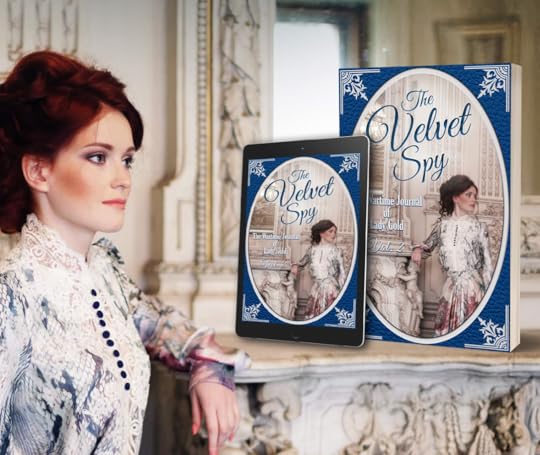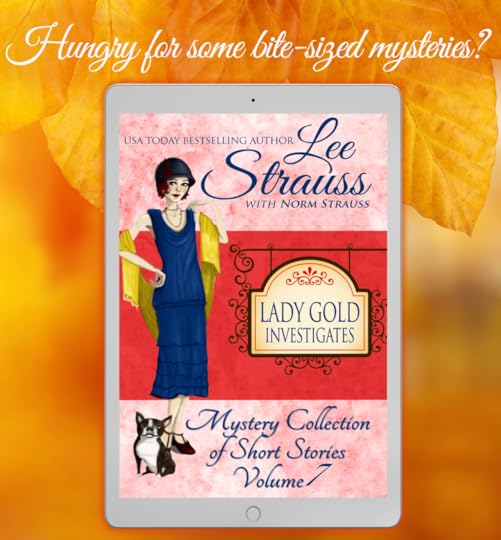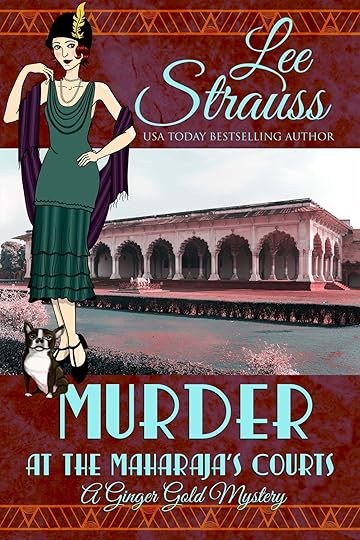Lee Strauss's Blog
November 4, 2025
Behind the Pearls and Cloche Hats: The Creation of Ginger Gold
I asked AI for five questions readers might ask me.
"Ginger Gold" is such a memorable name. How did you decide on it, and what does it reveal about her character—the fiery "Ginger" spirit contrasted with the wealth and status of "Gold"?
🌟 I'm trying to remember how I came upon the name Ginger. To be honest, my subconscious must have been thinking about the character from Gilligan's Island, because I do remember thinking Grant would make a good last name, lol. I like that AI thinks I chose "Ginger" for her fiery spirt and "Gold" for her wealth and status, but I chose Gold only because I was looking for a last name that started with G and had a ring to it when paired with Ginger.
2. Ginger is a Boston transplant who married into British aristocracy. How did her upbringing between the old money of America and the titled nobility of England uniquely prepare her (or fail to prepare her) for a life of solving crimes?
🌟 Well, for one thing, she never has to worry about money. Not having to work a day job gives her time to be curious and inquisitive. I don't think either old money or titles necessarily prepared her to solve crimes. Rather her skills are God-given gifts she honed over time.
3. Ginger is known for her impeccable, fashionable flair. Did you conceive of her love for fashion and running a dress shop, "Ginger's Gold," first as a character trait, or did it evolve as a clever tool for her investigations—allowing her access to different social circles and a perfect cover for sleuthing?
🌟 It was definitely a character trait from the beginning. How could I not include a love of fashion when the story is set in the 1920s?
4. A pivotal part of Ginger's origin is her background as a war widow and her work as a British Intelligence agent during WWI. How do these profound experiences of loss and espionage shape the woman she is when we meet her in the first book, and how do they fuel her talent for detection?
🌟 The WW1 secret agent angle was a backstory thread that developed over time, especially in the form of Ginger's Journal entries, which I recently published as The Velvet Spy volumes. Had I understood the gravity of her past when I started the first book, Murder on the SS Rosa, I probably would've written her with a more serious personality than I did. But, maybe it's a good thing! I like that Ginger is a glass half full kind of gal!
5. The dynamic between Ginger and the handsome Scotland Yard Chief Inspector, Basil Reed, is central to the series. When you first created Ginger, did you always know she would have a counterpart like Basil, and how did you develop their "will-they-won't-they" partnership to complement her independent nature?
🌟 Yes, I absolutely had him planned from the beginning. I took my cue from Miss Fisher's Mysteries TV series. Part of the big draw to that show for me was the slow burn romance between her and her detective.
What did you think? Pretty great questions. Speaking of questions, I want to take yours at a live Facebook event I'm hosting (along with my husband Norm) on November 12. MARK YOUR CALENDAR!CLICK HERE TO JOIN https://www.facebook.com/events/1832944697324518
You must be a member of my Facebook reader group to come. You can join my group here: https://www.facebook.com/groups/152435558596725
Hope to see you there!
October 22, 2025
5 Reasons to Give Short Stories a Try
When most people think about reading, they picture sinking into a full-length novel that takes days (or weeks) to finish. But short stories offer their own unique kind of magic—bite-sized adventures that fit perfectly into a busy life. If you’ve never given short stories a try, here are five reasons to start (and why my Lady Gold Investigates series might be just the place to begin!).
1. They Fit Into Any ScheduleLife is busy, and sometimes you just want a story you can finish in a single sitting. Short stories are perfect for a coffee break, a train ride, or winding down before bed. Each Lady Gold Investigates mystery is designed to be enjoyed in about an hour or two—just long enough to sink into Ginger Gold’s world without feeling pressed for time.
2. They Pack a PunchShort stories don’t have the luxury of hundreds of pages. Every clue, every red herring, every witty line of dialogue has to count. That makes them sharp, focused, and often even more impactful. In Lady Gold Investigates, Ginger faces mysteries that may not involve murder but still carry plenty of intrigue, clever twists, and the occasional laugh-out-loud moment.
3. They’re Gateways to Favorite CharactersIf you already know Ginger Gold from the full-length novels, the short stories are a wonderful way to spend more time with her, Basil, Boss, and the rest of her world. If you’re new to the series, short stories are the perfect entry point—giving you a taste of 1920s London, cozy sleuthing, and a heroine who’s as stylish as she is sharp.
4. They Showcase CreativityShort fiction often allows authors to play. In Lady Gold Investigates, I get to explore mysteries outside the framework of murder—missing persons, stolen treasures, or secrets hidden in plain sight. These lighter, sometimes quirkier puzzles offer a fresh twist on the cozy mystery genre and let Ginger’s resourcefulness shine in new ways.
5. They’re Immensely SatisfyingThere’s something delightful about reaching the end of a story in one sitting. You get the full arc—setup, investigation, and clever resolution—without waiting days to know how it ends. Each Lady Gold Investigates tale is a self-contained mystery, so you can dip in whenever you need a quick escape to Jazz Age London.
There's a new Lady Gold Investigates 2-story volume!
Number 7!
October 13, 2025
Beyond the Turkey: Unpacking the Unique Story of Canadian Thanksgiving
Ah, Thanksgiving. The mere word conjures images of a laden table, a roasted turkey taking center stage, surrounded by family and friends. For many, this is an iconic American holiday. But just north of the border, in the land of maple syrup and "ehs," we celebrate our own version of Thanksgiving—and while it may look similar on the surface, its story, spirit, and timing are distinctly Canadian.
So, if you've ever wondered what sets a Canadian Thanksgiving apart, pull up a chair. We're diving into the heart of how and why we celebrate.
The First Major Difference: The "When"Let's start with the most obvious distinction: the date.
American Thanksgiving: Falls on the fourth Thursday of November. This timing places it just before the official start of the holiday shopping frenzy, creating a long weekend that kicks off the festive season.
Canadian Thanksgiving: Is celebrated on the second Monday of October. This isn't an arbitrary choice; it's deeply rooted in the rhythm of our northern climate.
One other notable difference: American's are fixed on that one day, the Thursday, to celebrate, whereas Canadians celebrate on any day over the weekend from Friday to Monday. At our house this year, we ate our turkey on the Saturday, while my son's family celebrated at his in-laws on Sunday. In other words, Jordan Turkey double-dipped!
Why October? Simply put, our harvest comes earlier. With winter's chill arriving sooner than in most of the United States, Canadian farmers have traditionally gathered their crops by the end of September. Our Thanksgiving is a genuine harvest festival, a natural pause to give thanks for the bounty of the land before the cold sets in.
And personally, I like having two months between Thanksgiving and Christmas Turkey dinners.
The "Why": A Different Historical OriginBoth countries trace their Thanksgiving origins to festivals of gratitude, but the stories are different.
The American tradition is famously linked to the 1621 Pilgrim feast at Plymouth, a foundational story of the American experience.
The Canadian story is older and less centralized. It's a tapestry of earlier, quieter celebrations:
1578: Martin Frobisher, an English explorer, held a ceremony in what is now Nunavut to give thanks for his safe arrival in the New World. This is often cited as one of the first "Thanksgivings" in Canada.
The Habitant Tradition: French settlers, arriving in New France (now Quebec) in the early 1600s, held feasts to celebrate a successful harvest, sharing their food with their Indigenous neighbours, who had been holding harvest festivals for millennia.
Canadian Thanksgiving isn't tied to a single, dramatic founding myth. Instead, it evolved from a quieter, more practical tradition of gratitude for the harvest and safe passage—a reflection of a nation built on gradual evolution rather than revolution.
The "How": The Canadian Celebration VibeWhile the menu is comfortingly familiar—turkey (or ham), stuffing, mashed potatoes, gravy, and seasonal vegetables like squash and Brussels sprouts—there are a few subtle Canadian twists.
The Main Event: Yes, we have turkey, but it might be served with a side of tourtière (a spiced meat pie from Quebec) or accompanied by a glaze made with maple syrup.
The Starches: Our stuffing might include wild rice, a nod to the grains native to the region. And for dessert? While pumpkin pie is universal, you're just as likely to find butter tarts or Nanaimo bars on the table.
The Atmosphere: Perhaps the biggest difference is the tone. Canadian Thanksgiving is often described as more low-key and relaxed. It’s less of a blockbuster travel holiday than its American counterpart. The focus is intensely on gathering with family and close friends for a hearty meal. With the date in October, it’s also a perfect "kitchen party" long weekend—a chance to enjoy the brilliant fall foliage, go for a crisp walk, and truly unwind.
Gratitude for the "Great White North"At its core, Canadian Thanksgiving is a pause. It’s a long weekend that forces us to stop and look around at the stunning beauty of our autumn landscape and reflect on the blessings of the year. It’s a gratitude that feels deeply connected to the land itself—for the harvest, for the vast forests, and for the communities that thrive here.
It’s a holiday that embodies a quieter, more reflective Canadian value: taking a moment to be thankful for the peace, prosperity, and natural beauty we are so fortunate to enjoy.
So, this October, as the leaves turn to fire and the air grows crisp, know that across Canada, families are gathering not just for a meal, but for a moment of genuine, quiet gratitude. It may not have the parades or the fanfare, but its warmth and sincerity are every bit as meaningful.
Happy Thanksgiving, eh
September 16, 2025
Unlocking the Secrets of the Closed Room Mystery
A closed room mystery (sometimes called a locked room mystery) is one of the most tantalizing subgenres of crime fiction. The premise is deceptively simple: a crime—often a murder—is committed under circumstances that either make it appear impossible. It's clear that the crime was committed by someone in the room, but leaves the questions of who and how. The crime scene may be a locked room, a sealed chamber, or an isolated location where the culprit seemingly couldn’t have entered or escaped. The delight for readers comes from watching the detective unravel the paradox, proving that even the most “impossible” crime has a logical explanation.
At the heart of these mysteries lies the puzzle. They emphasize clever construction, fair play with clues, and a final twist that leaves the reader simultaneously surprised and satisfied.
2. Famous / Popular Closed Room MysteriesThe tradition of the locked room puzzle dates back centuries, but some novels have cemented the trope’s reputation:
Edgar Allan Poe’s The Murders in the Rue Morgue (1841): Often cited as the first locked room mystery, it introduced the idea of a seemingly impossible crime solved through reasoning.
John Dickson Carr’s The Hollow Man (1935): Considered by many the definitive locked room mystery, it even includes a famous “lecture” on the mechanics of impossible crimes.
Agatha Christie’s And Then There Were None (1939): While not technically a locked room in the physical sense, the isolation of an island creates the same claustrophobic “no escape” atmosphere.
Arthur Conan Doyle’s Sherlock Holmes stories: Several, such as The Adventure of the Speckled Band, flirt with the locked room format, showing its adaptability.
These works demonstrate how the format can be stretched: from literal locked doors to isolated settings, the essence is always that sense of impossibility.
3. The Knives Out Mysteries Movies - a contemporary exampleRian Johnson’s Knives Out films (Knives Out, 2019 and Glass Onion, 2022, with Wake Up Dead Man coming this fall) breathe new life into the closed room tradition.
In Knives Out, the mystery unfolds within the Thrombey family’s sprawling mansion—a modern take on the locked house setting. Every character is trapped in a web of suspicion, and Daniel Craig’s eccentric detective Benoit Blanc must untangle the knot of lies.
Glass Onion expands the concept by moving the story to an isolated island during a billionaire’s weekend retreat. The “locked room” here is the social circle and the cut-off location, making escape or outside interference impossible.
In Wake Up Dead Man, the murder occurs in a closed concrete room in a church.The trailer looks awesome, and I can't wait to see the movie. You can watch the trailer here:
These films show how adaptable the trope remains, bringing the puzzle-box feel of golden-age mysteries into the 21st century with humour, style, and social commentary.
4. The Closed Room Aspect of Murder in the Painted MaskMy mystery, Murder in the Painted Mask, takes inspiration from this long tradition. Lady Ginger Gold and her husband Basil attend a glamorous masked event at the country estate of Lady Horatia Zouch-Nettleby. When the provocative artist Lucien Valentino is discovered gruesomely murdered, the circumstances point to a classic “closed room” scenario.
The estate’s private auction and masked festivities mean that every guest is both a potential suspect and effectively “trapped” within the walls of the house. Secrets swirl behind masks, alibis crumble under scrutiny, and Ginger must determine not only who committed the murder, but how it could have happened under such tightly contained circumstances.
Like the great closed room mysteries before it, Murder in the Painted Mask balances atmosphere, glamour, and puzzle-solving, offering readers the thrill of trying to crack the impossible before Ginger herself cracks the case.
If you haven't preordered already, you can get it on Amazon or directly from me:
Early Goodreads Review:Absolutely fantastic! The Ginger Gold series never disappoints! I’ve been following this series for a while; read every book and started the audiobooks. The characters are divine and the plot is incredibly intriguing! A well hidden mystery, it keeps you guessing right up until the big reveal! I, honestly, didn’t figure it out; my favorite kind of mystery!
Murder in the Painted Mask is outstanding! I love the fact the plot takes places inside an estate where everyone is appears to be clear of the crime; but are they really?
Ginger and Basil are wonderful, as always. Charles and Felicia being there with them added another enjoyable aspect to the story. Boss, too, is a crucial element in the story.
I don’t want to say too much more for the fear of giving away spoilers. I’ll leave this review with my recommendation. I highly recommend Murder in the Painted Mask and the Ginger Gold mystery series. Whether you start with this book or work your way through from the beginning, I promise you will not be disappointed.
Curl up in your favorite reading spot and start reading today! It’s worth it!
Emily Gawlak
See all reviews: https://www.goodreads.com/book/show/236059552-murder-in-the-painted-maskCOMING SOON
After spending a whole book in one location (pretty much) I felt the need to take Ginger far and wide, so in the next book, she's going to India!
MURDER AT THE MAHARAJA'S COURTS
Murder is a world away...Lady Ginger Gold never imagined her journey to Rajasthan would draw her into the glittering yet perilous world of a royal court. Invited with her husband Basil to a lavish celebration at a maharaja’s palace, she is swept into a realm of jewelled elephants, opulent banquets, and the thrill of a tiger hunt in the desert.
But when a guest is gunned down during the hunt, whispers ripple through the gilded halls. Was the bullet meant for the victim—or for the maharaja himself? As Ginger unravels a web of intrigue, she uncovers dangerous undercurrents: British officials with secrets to hide, courtiers with shifting loyalties, and whispers of rebellion against the Crown.
Amid growing rebellion and corruption, Ginger must unmask a killer before palace intrigue turns deadly.Q 4 U
Have you watched the Knives Out Movies? Are you looking forward to the next one? Let me know in the comments.
September 9, 2025
What kept me busy this summer - personal blog
It's been a summer of transition. Actually, it's been a year of transition, but a move in a good direction. Last fall we moved into our house (it had been rented out previously.) It was a move on top of a move, and I was so exhausted by the time we got in. Mostly we just stuffed our things into boxes and threw them into the garage or storage room, and basically forgot about them, because, shortly after our move, we became first time grandparents!
All that to say, the summer has been busy because we're still settling into our house, but also because we moved from having no yard, to having a big yard. I'd forgotten how much work owning a house with a yard could be!
This yard came with many fruit trees and a whole lotta weeds. Tall weeds, front and back. Once the weather warmed, Norm and I and our son Jordan (our work and sometimes personal assistant), worked tirelessly, picking weeds, pruning and prepping fruit trees and building a patio. I also thought it would be a great idea to plant a garden. OMG, my tomatoes went wild and, why did I plant so many pumpkins?!?

Here's the patio is still a work in process, but I'm happy with the old-world look of the stone work, and the soothing water fountain. Next year I'll continue xeriscaping.

A small sample of the canning and preserving I've done. I feel like pioneer woman now! :)
But the best thing that kept me busy was this little man. Most days he'd come for a visit, about an hour or so, and I just love my time with him.

We started publishing German translations this year and, if you've been watching, Ginger's Journal was released as a 2 volume series called The Velvet Spy.
I wrote book 27, Murder in the Painted Mask, which is going out to ARC readers this week, for September 25 release. And now I'm plotting book 28, which I'll announce soon.
What about you?How have you kept busy this summer? Let me know in the comments.
August 6, 2025
Before the Mysteries: Who Was Lady Gold During the War?
Long before Lady Ginger Gold became the fashionable sleuth of 1920s London—solving murders in tea rooms, jazz clubs, and country estates—she was someone very different. Beneath the pearls and perfectly tailored hats lies a woman forged in the crucible of war, a woman who risked her life behind enemy lines, armed not with a revolver, but with intelligence, nerve, and an iron will.
The Velvet Spy duology explores the hidden chapters of Ginger’s life during the First World War—years that transformed her from a well-bred young woman into someone capable of staring down danger and uncovering the truth in the shadows.
But who was she before the mysteries? And how did the war shape the lady we’ve come to know and love?
Let’s take a look behind the curtain.
From Society Debutante to Secret AgentGinger Gold entered the Great War not as a soldier, but as a volunteer with a cause. In 1915, she was just a young widow in Boston, working with the Red Cross and the war effort from afar. But a fateful letter from British Intelligence changed everything. Called back to England and offered a position with the Secret Service Bureau, Ginger made the bold choice to enter a world where few women—and fewer civilians—were ever invited.
Why her? Ginger’s fluency in French, her upbringing across Europe, and her steely composure in crisis made her uniquely suited for espionage work. She could move through society undetected, slip into foreign identities with ease, and maintain perfect decorum while gathering sensitive intelligence.
A New Kind of BattlefieldUnlike the glamorous spy thrillers of later decades, World War I espionage was a brutal, unglamorous game. Ginger's missions brought her into the heart of occupied France and Belgium, where every street corner might conceal a German patrol, and every smile could mask betrayal. She worked alongside brave members of the resistance—many of them women like herself—who carried messages, smuggled soldiers, and risked torture or execution daily.
In The Velvet Spy, we see Ginger infiltrating enemy strongholds under assumed names, decoding secret signals, and using every ounce of intuition to stay one step ahead of danger. There are no gadgets, no backup teams, and no safety nets. Only quick thinking, trust in her instincts, and the quiet determination to do what’s right—even when it costs dearly.
These were formative years. The Ginger of the war years was both vulnerable and fearless. She cried in the dark and then rose in the morning to do what had to be done. She bore witness to brutality, mourned fallen friends, and endured betrayal. And yet, through it all, she carried herself with grace, courage, and deep empathy for those caught in the machinery of war.
The Making of a SleuthWhen we meet Ginger again in The Ginger Gold Mysteries, she’s living in a very different world. It’s 1920s London: a time of jazz, flappers, and post-war optimism. On the surface, she’s the picture of elegance—a fashion house owner, a doting mother, a Lady by marriage. But her wartime past never fully leaves her.
Why does she so often step into danger to solve a murder no one else will? Why does she instinctively see through lies and read the unsaid in a room full of suspects? Why does she take risks others would balk at?
Because she’s done it before. Ginger’s wartime experiences sharpened her instincts and taught her to trust them. Her background in espionage made her keenly observant and disarmingly charming—tools that serve her well when interrogating suspects or navigating Scotland Yard bureaucracy.
And her sense of justice? That comes from seeing too much injustice go unpunished. Her determination to speak for the silenced, to fight for the voiceless, was born in the shadows of occupied Europe.
The Cost of BraveryBut The Velvet Spy isn’t just about missions and danger. It’s about the personal cost of service. The love Ginger shared with Daniel—her husband, her confidant, her great heartbreak—is woven deeply into these wartime journals. Their connection is tender, raw, and ultimately tragic. Through this relationship, readers glimpse Ginger’s vulnerability and the emotional weight she carries into her post-war life.
She doesn’t speak of Daniel in the mystery series often, but once you’ve read The Velvet Spy, you understand why. Some scars are too deep for casual conversation.
Besides there's Basil Reed!
Why Readers Should Start HereIf you’re new to the Ginger Gold Mysteries, The Velvet Spy offers the perfect starting point. It introduces you to the younger Ginger—before the title, before the fame—and shows the origin of her resilience, her wit, and her capacity to care in a world gone mad.
If you’re already a fan of the series, this duology enriches your understanding of the character you thought you knew. It deepens every later moment of intuition, courage, or hesitation. Suddenly, you see the war ghosting behind her calm smile. You see Daniel in the silence. You see how every decision in the 1920s is shaped by what happened in the 1910s.
From Velvet to GoldThe Velvet Spy reminds us that even cozy mystery heroines have hard histories. That strength often comes from surviving what others could not. That elegance can be a form of armour—and sometimes, underneath the tailored dress and feathered hat, beats the heart of a warrior.
So the next time Ginger Gold steps onto the scene of a murder with her trademark poise and precision, remember: she’s not just a stylish sleuth.
She’s a survivor. A spy. And a woman who’s already faced the darkest corners of the world—and chosen to stand in the light.

AVAILABLE NOW
June 11, 2025
Tending Gardens in Uncertain Times
The heat arrived early this year. Our little corner of the world feels more like late July than early June, and like many of you, we’ve been outside nearly every day — building new flower beds, hauling rock, clearing brush, and watering almost constantly. Part of it is the simple joy of watching a new garden come to life, but part of it, too, is preparation. Fire season has become part of our yearly rhythm now, and we do what we can: clearing fallen branches, trimming back overgrowth, and trying to make our home a little more resilient.
In between the digging and watering, I’ve been working steadily on my final edits for The Velvet Spy: Volume 2 as well as drafting the 27th Ginger Gold Mystery. It’s quite something to live half the day with one’s hands in the earth, and the other half lost in 1917 France or 1920s London. My grandson—now eight months old—often visits during the day, and watching him discover the world with such bright-eyed wonder reminds me of what a precious, fragile place this is. Both the world itself, and the time we’re given to live in it.
As I’ve been writing these latest chapters of The Velvet Spy, I’ve found myself returning to an image that feels strangely relevant even now: the gardeners of war.
During World War I, amid the devastation of the trenches, soldiers and civilians alike often planted small gardens wherever they could. Tiny plots of poppies or beans grew between shattered buildings. Window boxes appeared in battered towns. Even in the trenches themselves, some soldiers planted little patches of flowers — not because they had to, but because they needed to. In the face of destruction, life asserted itself. Growth became both an act of hope and quiet defiance.
Today, we live in a world facing its own upheavals — though thankfully, for most of us, not on the scale of 1917 France. But whether it’s wildfires, political tensions, or simply the uncertainties that seem to swirl louder each year, I think many of us are planting our own kinds of gardens right now. Whether it’s a literal flower bed, time spent with grandchildren, or creative work like writing books, we’re all cultivating something that helps push back the darkness, even just a little.
Perhaps that’s the small WWI lesson I’m carrying with me this season: you cannot always control the larger forces around you, but you can tend your small patch of earth. You can create beauty. You can nurture life. You can pass something good to the next generation.
Thank you, as always, for being part of this journey with me. I’ll leave you with a few photos of our garden-in-progress. The flowers aren’t quite in full bloom yet—but like all good things, they’re growing, one day at a time.

Stay safe, stay well — and wherever you are, may your own small gardens thrive.
Book News!
The Velvet Spy: The Wartime Journal of Lady Gold - Volume Two Dive deeper into Ginger’s past with this gripping wartime journal. Secrets, espionage, and high-stakes danger await in this second and final volume of Lady Gold’s clandestine adventures.
 PRE-ORDER
PRE-ORDERMurder in the Painted Masque: A Ginger Gold Mystery When a lavish masquerade ball turns deadly, Ginger must unmask a killer hiding behind silk and jewels. Glamour, deception, and a twist-filled mystery—perfect for fans of classic whodunits!
 PRE-ORDER
PRE-ORDERAnd something for my German speaking readers... Book 6 of the Ginger Gold Mysteries series is coming soon in German!
Mord in den Kensington Gardens: Ein Fall für Ginger Gold 6 Für unsere deutschsprachigen Leser: Ginger Gold ermittelt wieder! In diesem charmanten Cosy-Krimi wird ein idyllischer Spaziergang durch die Kensington Gardens zum Tatort—und nur Ginger kann das Rätsel lösen.
 Jetzt vorbestellen!
Jetzt vorbestellen!
Be entered to win 3 fantastic prizes

$25 Paypal Prize, Vintage World Map Puzzle + Paperback of 'The Velvet Spy: Volume Two'
May 22, 2025
Read an excerpt of The Velvet Spy
I'm really excited to bring The Velvet Spy into the world. Some fans of the Ginger Gold Mysteries have been following along on Ginger's WW1 espionage experiences through her Journal entries. These little unedited vignettes were for the benefit of my newsletter subscribers, and when I started, I hadn't envisioned that one day I'd have enough story for two volumes!
The journal entries have now been expanded, edited with new entries included to create an emotional, full story experience. Here is the first one for your enjoyment!
July 31st, 1912
How fabulous that I found this journal today, tucked away at the bottom of my wardrobe! Good old Pippins—our English butler in London—gave it to me years ago as a parting gift when Father whisked me off to America so he could marry Sally. Pips said it was for me to record my new adventures.
I’m ashamed to admit I didn’t pen a single word until today. I think I was simply too sad back then. But no matter—I’m writing now, and this will be the first of many entries, I hope. I imagine myself as an old woman, sitting by the fire, thumbing through these pages as they bring back cherished memories of a long and adventure-filled life.
This old leather-bound journal takes me right back to that emotional time. I cried enough tears to fill an ocean and remember telling Father, dramatically, that I would surely cause a flood to rival Noah’s. At eight years old, I was well-versed in my biblical studies, though in hindsight, I might have bordered on heresy with my little tantrum.
The first week of my so-called “adventure” was spent aboard a big steamship, feeling wretchedly sick to my stomach the whole way. There were far too many embarrassing episodes involving a bucket and Father holding back my long hair so I wouldn’t soil it with vomit. I was convinced I was being punished for some unknown offense.
Hartigan House—though large and sometimes lonely—was my home. And Pips, dear Pips, was my good friend. He often entertained me with games of I Spy or Noughts and Crosses.
“Very good, Little Miss,” he’d say with a twinkle in his blue eyes when I won, which I did often. Looking back, I suspect Pips wasn’t above letting me win, even when I hadn’t earned it.
Father claimed he’d uprooted us because I needed a mother, though I think he simply wanted a wife. Sally—a woman half his age—turned out to be a sufficient spouse in the end, but I could never bring myself to call her “Mother.”
Well, Pips, you’d be glad to know things turned out all right here in America. My childhood was pleasant—school, new friends, and learning to ride horses and shoot guns, a pastime that’s very popular here, even beyond the elite. I went to an excellent school, and I focused on studying modern languages and science. Boston is a beautiful city, and much of it reminds me of England.
Oh, and I suppose I should mention that Father and Sally produced a sister for me—Louisa. She’s dark-haired, with a sweet teardrop-shaped face, and the very image of Sally. I don’t hold that against her, though. She’s as spoiled as they come, with Sally pandering to her every whim and Father far less strict with her than he ever was with me. With ten years between us, we don’t have much in common, but I adore her all the same.
This afternoon was spent preparing for the evening’s activities. Father was hosting a soirée in honor of my nineteenth birthday, and I planned to enjoy a large slice of Mrs. Bakker’s Dutch Dark Chocolate Cake. Her cakes are legendary—so rich and moist they melt in your mouth like cocoa-laced ecstasy. My mouth waters just thinking about them.
Father adores throwing soirées—or as in this case, “dinner parties,” as the Americans call them. I often feel caught between two cultures. Outside this Beacon Hill brownstone, I’m American, but inside, I cling to my English roots. Father and I still enjoy traditional tea with scones and clotted cream, served properly, the English way. Our conversations often turn to politics—both here and across the Atlantic. Some of the news is deeply worrisome, but I won’t dwell on that tonight.
“Not too tight,” I told my maid Molly as she tightened the straps on my corset. The columnar corset forced me to stand straight and tall, though I silently thanked the heavens that those horrid S-bend corsets had gone out of fashion. It’s a wonder we aren’t all deformed!
Molly helped me into a gown of shiny emerald silk, with an open neckline and slender sleeves that ended at my elbows. I spun in front of the long mirror, admiring the fitted gown with its beautifully contrasting lace ruffle.
“The color brings out your eyes, Miss Hartigan,” Molly said as she pinned my red hair into an elegant coiffure, a delicate wreath of ribbon encircling the style.
Molly held up a hand mirror. “You’ll be the belle of the ball, miss.”
“Thank you, Molly,” I said, smiling. “I’m excited for the evening, though I do wish Father hadn’t assigned me a date.”
An English gentleman would be joining the festivities, he’d announced. Apparently, the gentleman is the son of a family friend—a baron, no less. I worry my American friends might find his title pompous. No matter. After tonight, I doubt I’ll see him again.
What did Father say his name was? Right—Daniel, Lord Gold.
April 23, 2025
Contest Alert - TWO contests to celebrate The Velvet Spy volume 1
The Gleam contest is open to all. The Goodreads contest (Amazon policy) is open to US readers only.
Good luck!
 Enter to win a paperback copy of The Velvet Spy Vol 1, a candle stick holder and $25 paypal cash!
Enter to win a paperback copy of The Velvet Spy Vol 1, a candle stick holder and $25 paypal cash!
Gleam: https://gleam.io/x29po/velvet-spy-the-wartime-journal-of-lady-gold-volume-one
April 9, 2025
Ginger's Journal is now The Velvet Spy! And a bit of Ginger Gold history.
Most readers of this blog already know Ginger Gold is my break out character in the Ginger Gold mystery series. I released the first book in May of 2017, and had no idea how big this world would become. Currently, there are 26 books in the main series, 2 spin-off series( 6 Higgins and Hawke and 10 Rosa Reed books), 12 short stories (Lady Gold Investigates) and a prequel short story (Mayhem or Miss the Boat.)
And an extensive accounting of Ginger's life as a spy during WW1.I don't remember exactly when I decided to write about Ginger's life prior to the start of the Ginger Gold Mystery series. The idea germinated as I wrote the initial books and made references to her life "before." After a while, it made sense to track these or future reference. At the same time, I wanted to do something special for my newsletter list. These readers believed in me enough to agree to hear from me semi-regularly, and I wanted to do something unique for them. Thus, Ginger's Journal was born.
Initially the books informed the journal, but over time, the journal started informing the books, meaning ideas from the journal would end up in my books, not the other way around!
It became obvious that the journal had a life of its own. I had proof of this through newsletter opening stats. Anytime I included a journal entry, the open email stats jumped significantly!
Eventually, the inevitable happened, and I came to the end of the war years and reached the days leading up to the beginning of the series.
The question what to do with this unedited, randomly organised material?
I asked my readers if they'd like to see the journal expanded and edited and available for sale as a new book - two new books, actually, because of the volume of material in the journals - and the answer came back as a solid YES.
And so, The Velvet Spy was born.

Step into the courageous world of espionage and resilience.
This extraordinary volume unveils the hidden life of Lady Ginger Gold, a daring operative for British Intelligence during the Great War.
Through her vivid and deeply personal journal entries, Lady Gold pens the tension of covert missions behind enemy lines, the heartache of separation from loved ones, and the triumphs and sacrifices that shaped history. From navigating dangerous assignments in occupied France to outwitting German spies and forging alliances in the unlikeliest of places, Lady Gold's story is one of bravery and determination in a world torn apart by war.
With her sharp wit and unwavering resolve, Lady Gold immerses readers in the chaos and heroism of a time when ordinary individuals rose to face extraordinary challenges. The Velvet Spy is not just a tale of espionage—it is a testament to the indomitable spirit of a woman who risked everything to serve her country.
Preorder Amazon: https://books2read.com/VelvetSpy1Preorder directly from me: https://leestraussbooks.com/
Were you/are you a fan of Ginger's Journal? What was it that you liked about it? Are you looking forward to a "beefed up" version?









